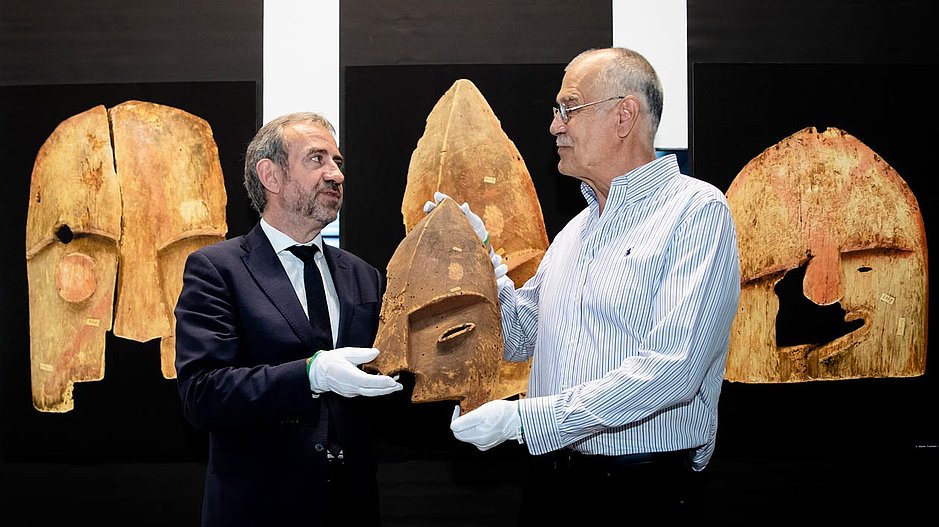Bereichsnavigation
Restitution and Other Solutions
Several objects from the Ethnological Museum have already been restituted or repatriated. Returning an object is, however, only one of many possible solutions. These are worked out in dialogue with members of the societies of origin.
In the course of discussions with the representatives of societies of origin, the expectation that objects will be returned is sometimes expressed, but often other solutions are expected as well. Above all, it is considered essential that the collection is made accessible and that the objects are treated respectfully.
So far, official claims for return (claims made under a mutual agreement between the societies of origin and the government of the respective country) have only been lodged in a few cases. Not all of these concern objects from colonial contexts. Possible solutions for the affected items in a collection are developed in direct contact with representatives of the societies of origin.
The Return of Objects from the Ethnologisches Museum
A recent example of items being returned from the Ethnologisches Museum was in 2018, when the SPK restituted nine objects, originally from Chenega Island off the south coast of Alaska, to the Chugach Alaska Corporation. These were grave goods, which had been taken from burial sites without the consent of the native people. The Ethnologisches Museum has been working with the Chugach Alaska Corporation since 2015 to reappraise its collection, which contains around two hundred objects from this region.
In 2000, an object from the Ethnologisches Museum was repatriated to Zimbabwe. The SPK gave a fragment of a "Zimbabwe bird", around 45 cm tall, on permanent loan to the country's national museum, which already possessed the other part of the sculpture. The fragment in Berlin had been purchased for the collection of the Royal Museums in 1906. This and comparable bird sculptures have special significance for the identity of today's Zimbabwe and are closely associated with the country's struggle for freedom and independence. The SPK therefore decided to make the permanent loan in support of Zimbabwe's efforts to present all of the surviving “Zimbabwe birds” – of which eight are known to exist – in their country of origin.
One part of a collection for which a solution is still being sought is the inventory of objects that were brought to Berlin during the colonial era from regions of what is now Tanzania. A project team has investigated the history of the collection, the historical circumstances, and the context of its acquisition. The Stiftung Preussischer Kulturbesitz has already signaled that it intends to return objects from the context of the Maji Maji war to Tanzania. The specific details of how this is to be done are currently being clarified.
Another case of restitution concerns the Mesoamerican archaeological collection of the Ethnologisches Museum. In 1980, the museum received a gift that could not be attributed precisely at the time. In the 1990s, this Mayan object was found to be a fragment of Machaquila stela 11 from Petén in Guatemala. Since there was photographic proof that the piece had still been at its original location in the late 1960s, it must have been brought to Europe illegally. Although the UNESCO Convention on the Illicit Trafficking of Cultural Property, from 1970, was not ratified in German law until 2007, the SPK contacted the Guatemalan embassy in Germany and offered to restitute the object. It was handed over in 1999.
In order to decide how best to deal with art from the former kingdom of Benin, a group of museums from different countries got together with representatives from Nigeria a few years ago and formed the Benin Dialogue Group. The Ethnological Museum was a member of the group from the start. Art from the former kingdom of Benin was dispersed and ended up in museums around the world after conquest by a British colonial force in 1897. In October 2018, the Benin Dialogue Group agreed that a new museum should be created in Benin City with a regularly changing exhibition, for which European and Nigerian museums would make works of art available.
Documents for Downloading
Links for Additional Information
Related News
Parzinger: Benin Bronzes Must Be Publicly Exhibited
09.05.2023 - SPK president reacts to media reports that Nigeria’s departing President Buhari has transferred ownership of all objects to Oba Ewuare II, the successor to the kings of Benin.
New Publication: Results of the Provenance Research on Skulls from German East Africa
18.01.2023 - Following the completion of provenance research on skulls from German East Africa, an extensive report on the pilot project has now been published. “We are prepared to restitute…
Close Cooperation with Colombia
16.09.2022 - The SPK and the Colombian Embassy have begun discussions on two important masks of the Kogi indigenous people
514 Berlin Benin bronzes return to Nigerian ownership
25.08.2022 - The "Benin bronzes" officially belong to Nigeria again. About a third of the transferred objects will remain on loan in Berlin and will be exhibited in the Humboldt Forum.


